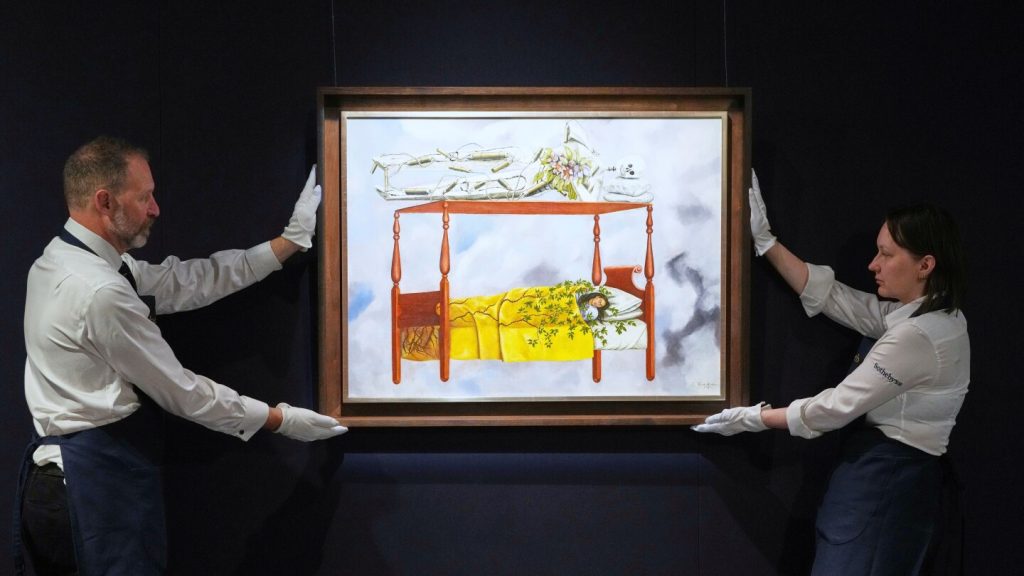Listen to the article
Frida Kahlo’s iconic painting “El sueño (La cama)” is poised to make art history as Sotheby’s prepares to auction the masterpiece for an estimated $40 million to $60 million on November 20 in New York. If realized, this price would establish new records for both female and Latin American artists in the global art market.
The painting has already embarked on a prestigious world tour, with exhibitions in London, Abu Dhabi, Hong Kong, and Paris generating significant international interest ahead of the sale.
“This is a moment of a lot of speculation,” notes Helena Chávez Mac Gregor, a prominent Mexican art historian and researcher at UNAM’s Institute of Aesthetic Research who authored “The ribbon and the bomb. The art of Frida Kahlo.”
The auction raises complex questions about cultural heritage and art ownership. Within Mexico, Kahlo’s work is legally protected as artistic monuments that cannot be sold or destroyed. However, “El sueño (La cama)” belongs to an undisclosed private collector abroad, placing it beyond Mexican protective legislation and eligible for international sale.
“The system of declaring Mexican modern artistic heritage is very anomalous,” explains Cuauhtémoc Medina, a respected Mexican curator and art historian specializing in contemporary art.
Created in 1940 following Kahlo’s visit to Paris, “El sueño (La cama)” showcases the artist’s distinctive symbolism and cultural references. The painting features a striking cardboard Judas figure on the bed’s canopy—not a Day of the Dead skeleton as commonly misinterpreted. This effigy represents Judas Iscariot, traditionally burned during Easter celebrations to symbolize purification and the triumph of good over evil.
The skeleton is elaborately decorated with firecrackers, flowers adorning its ribs, and a grimacing smile—a detail inspired by an actual cardboard skeleton Kahlo kept above her own bed. This personal touch reflects Kahlo’s complex relationship with mortality as she “spent a lot of time in bed waiting for death,” according to Chávez Mac Gregor, referring to the artist’s lifelong physical challenges from polio and a serious bus accident in her youth.
Though the painting is being auctioned alongside works by celebrated surrealists including Salvador Dalí, René Magritte, and Max Ernst, Kahlo maintained a complicated relationship with the movement. While André Breton, surrealism’s founder, was “fascinated by Frida’s work” and organized her 1939 Paris exhibition, Kahlo herself rejected the surrealist label.
As a dedicated communist, Kahlo viewed surrealism—with its focus on consciousness revolution—as fundamentally bourgeois. Nevertheless, art experts identify surrealist elements in her work, particularly in the dreamlike imagery of “El sueño (La cama),” which depicts the artist sleeping peacefully among vines on a bed suspended in the sky.
The fate of this masterpiece after auction remains uncertain. Like many high-value art acquisitions, it may disappear from public view indefinitely. There are exceptions, however, such as Kahlo’s “Diego y yo,” which sold for $34.9 million in 2021—her current auction record—and was subsequently loaned to the Museum of Latin American Art in Buenos Aires by Argentine businessman Eduardo Costantini.
Art historian Medina laments that these “crazy-priced” purchases often reduce art to mere investment assets. He notes that wealthy buyers frequently store valuable artworks in tax-free zones, sometimes “in a refrigerator at Frankfurt airport for decades to come,” removing cultural treasures from public appreciation.
The auction highlights persistent gender disparities in the art market. The current record for a female artist belongs to Georgia O’Keeffe’s “Jimson Weed/White Flower No. 1,” which sold for $44.4 million in 2014. However, this figure pales in comparison to the highest price ever paid at auction—$450.3 million for “Salvator Mundi,” attributed to Leonardo da Vinci, sold in 2017.
As the art world watches with anticipation, Kahlo’s distinctive painting stands on the threshold of potentially transforming market valuations for both female and Latin American artists, challenging longstanding inequities in how the art market values works from beyond the traditional Western male canon.
Fact Checker
Verify the accuracy of this article using The Disinformation Commission analysis and real-time sources.




9 Comments
Silver leverage is strong here; beta cuts both ways though.
Exploration results look promising, but permitting will be the key risk.
Good point. Watching costs and grades closely.
Uranium names keep pushing higher—supply still tight into 2026.
Uranium names keep pushing higher—supply still tight into 2026.
Good point. Watching costs and grades closely.
Production mix shifting toward Business might help margins if metals stay firm.
Interesting update on Mexican art historians weigh in on upcoming Kahlo’s auction that could fetch up to $60 million. Curious how the grades will trend next quarter.
Good point. Watching costs and grades closely.